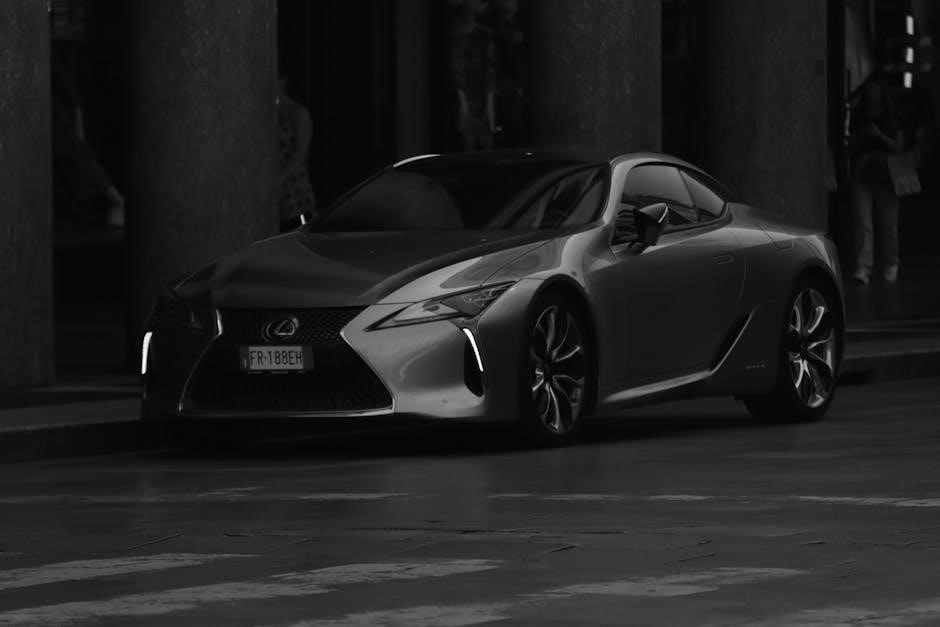Lexus, known for luxury and innovation, offers select manual transmission models, blending driving engagement with premium comfort, while exploring future EV manual transmission technologies.
Overview of Lexus and Its Transmission History
Lexus, Toyota’s luxury division, has explored various transmission technologies, including manual, to enhance driving engagement. Early models like the Lexus IS200 and IS250 offered manual options, catering to enthusiasts. The 2012 Lexus IS 250 was the last U.S. model with a manual transmission. Historically, Lexus focused on refining automatic and CVT systems, aligning with market trends. However, recent developments, such as the Lexus Electrified Sport concept, hint at a return to manual transmissions in future EVs, blending heritage with innovation. This shift underscores Lexus’s commitment to balancing luxury, performance, and driver interaction.
Importance of Manual Transmissions in Lexus Vehicles
Manual transmissions in Lexus vehicles emphasize driver engagement and control, appealing to enthusiasts who value the tactile experience of shifting gears. They provide precise acceleration and a direct connection to the car’s performance, enhancing the driving experience. While Lexus has shifted focus to automatics, the recent Electrified Sport concept suggests a potential revival of manuals in EVs, aiming to preserve the joy of driving. This blend of heritage and innovation highlights Lexus’s commitment to offering both luxury and dynamic performance, ensuring that manual transmissions remain a cherished option for purists and driving enthusiasts alike.

Historical Overview of Lexus Manual Cars
Lexus introduced manual transmissions in early models like the IS 250, offering a sporty driving experience before shifting focus to automatics, reflecting market preferences and technological advancements.

Discontinued Manual Transmission Models
Lexus once offered manual transmissions in models like the IS 250 and IS 350, providing a sporty driving experience. However, these options were phased out by 2012, as the brand shifted towards automatic and CVT transmissions to meet market demands and improve fuel efficiency. The discontinuation marked the end of an era for Lexus manual cars, leaving enthusiasts to seek older models for a stick-shift experience. Despite this, Lexus continues to explore innovative transmission technologies, hinting at potential future developments in manual or interactive driving systems.
Last Models with Manual Transmission Option
The 2012 Lexus IS 250 and IS 350 were the final models to feature a manual transmission option. These vehicles offered a six-speed manual gearbox, providing drivers with a more engaging and sporty driving experience. The IS 250, in particular, was popular among enthusiasts for its combination of performance and handling. After 2012, Lexus shifted exclusively to automatic and CVT transmissions, discontinuing manual options across its lineup. These last manual models remain sought after by driving purists who value the connection and control offered by a stick-shift. The discontinuation of manual transmissions marked a significant shift in Lexus’ focus towards convenience and efficiency.

Decline of Manual Transmissions in Lexus
Lexus shifted focus to automatic and CVT transmissions, discontinuing manual options after 2012. This change reflected industry trends toward convenience and efficiency, aligning with consumer preferences.
Shift to Automatic and CVT Transmissions
Lexus transitioned to automatic and CVT transmissions to enhance comfort and efficiency, aligning with consumer demand for smoother, hands-free driving experiences. This strategic shift followed industry trends, optimizing performance and convenience, while phasing out manual options in favor of modern, driver-friendly technologies.
Market Trends and Consumer Preferences
Market trends reveal a decline in demand for manual transmissions, with consumers increasingly favoring automatic and CVT options for convenience and ease of use. Lexus, like many manufacturers, has responded by discontinuing manual transmissions in most models after 2012, as automatics and CVTs align better with modern driving preferences. The shift reflects broader industry movements, where smooth, hands-free driving experiences are prioritized over the engagement of manual shifting. However, niche interest in manual transmissions persists, particularly among enthusiasts, leading Lexus to explore innovative solutions like virtual manual modes and EV-compatible manual systems to cater to evolving consumer desires while maintaining its commitment to luxury and performance.

Resurgence of Manual Transmissions in Lexus
Lexus is reviving manual transmissions in select models, blending tradition with cutting-edge technology like EV-compatible systems and Interactive Manual Drive, ensuring a dynamic driving experience.
Lexus Electrified Sport and Manual Transmission Development
Lexus is pioneering manual transmission integration in electric vehicles, starting with the Electrified Sport. This EV features a simulated manual system, offering drivers a familiar yet futuristic driving experience. By incorporating advanced software, Lexus aims to replicate the engagement of a manual transmission without compromising efficiency. The project underscores Lexus’s commitment to preserving the joy of manual driving while embracing electrification. This innovative approach ensures that future EVs remain dynamic and engaging, catering to enthusiasts who value both performance and sustainability.
Interactive Manual Drive Technology
Lexus has introduced its innovative Interactive Manual Drive technology, designed to enhance driver engagement. This system simulates a manual shifting experience, allowing drivers to control power output seamlessly. Featured in the RZ 550e F SPORT, it offers a dynamic connection to the vehicle, blending traditional driving sensations with modern electrification. The technology ensures precise control, making every drive more immersive and enjoyable. By integrating this virtual manual gear shift system, Lexus continues to redefine the future of electric vehicles while preserving the essence of manual driving. This advancement highlights Lexus’s dedication to innovation and its commitment to delivering exceptional driving experiences.

Used Lexus Manual Cars
Pre-owned Lexus manual cars, such as the 2000 IS200 and 2005 IS250, offer a blend of luxury and driver engagement, remaining popular among enthusiasts seeking classic driving experiences.
Available Models and Specifications
Several pre-owned Lexus models with manual transmissions are available, including the 2000 Lexus IS200 Sports Luxury Manual and the 2005 Lexus IS250 Sports Luxury Manual. These models feature 6-cylinder engines, with the IS200 offering a 2.0L petrol engine and the IS250 equipped with a 2.2L petrol engine. The IS250 C and IS350 C were also offered with manual transmission options, providing drivers with a blend of performance and elegance. Specifications vary, but many models come with rear-wheel drive and optional all-wheel drive. The 2012 Lexus IS 250 and IS 350 were among the last models to feature manual transmissions, offering a 6-speed manual option. These cars are sought after by enthusiasts for their engaging driving experience and luxurious features, with prices ranging from $16,500 to $24,000 based on condition and mileage.
Market Demand for Pre-Owned Manual Lexus Cars
Market demand for pre-owned manual Lexus cars remains steady among driving enthusiasts seeking a blend of luxury and control. These vehicles, such as the 2000 IS200 and 2005 IS250, are popular for their 6-cylinder engines and rear-wheel drive setups. With prices ranging from $16,500 to $24,000, they attract buyers who value performance and craftsmanship. The 2012 IS 250, the last model with a manual transmission, is particularly sought after. While Lexus no longer produces manual cars, the used market caters to those who prefer the tactile driving experience. This niche demand underscores the enduring appeal of manual transmissions in the luxury segment, even as automatics dominate new sales.

Future of Manual Transmissions in Lexus
Lexus plans to integrate manual transmissions into future electric vehicles, enhancing driving engagement while preserving the manual experience for enthusiasts, aligning with their innovative electrification strategy.
Plans for Manual Transmission in Electric Vehicles
Lexus is developing manual transmissions for electric vehicles to enhance driver engagement. Toyota and Lexus aim to create EVs with a more engaging driving experience. The Lexus Electrified Sport concept features a manual transmission, offering a unique blend of EV technology and driver interaction. Chief Engineer Takashi Watanabe emphasized the goal of replicating the sensations of a manual transmission in an EV, using software-based systems. This approach ensures that future electric vehicles retain the excitement of manual driving while embracing sustainability. By integrating manual transmissions into EVs, Lexus aims to cater to enthusiasts who value both performance and environmental responsibility. This innovation underscores Lexus’s commitment to preserving the joy of driving in the electric era.
Role of Lexus in Preserving Manual Driving Experience
Lexus is playing a significant role in preserving the manual driving experience by innovating and reintroducing manual transmissions in its lineup. Despite the industry’s shift toward automatics, Lexus has committed to saving the manual by developing technologies like the Interactive Manual Drive system. This virtual manual gear shift system, debuted in the RZ 550e F SPORT, allows drivers to engage deeply with the vehicle, blending tradition with modern EV technology. By offering such innovations, Lexus caters to driving enthusiasts who value the tactile connection of manual driving. This effort not only preserves the joy of manual driving but also ensures that future generations can experience the thrill of shifting gears, even in an electric era.
